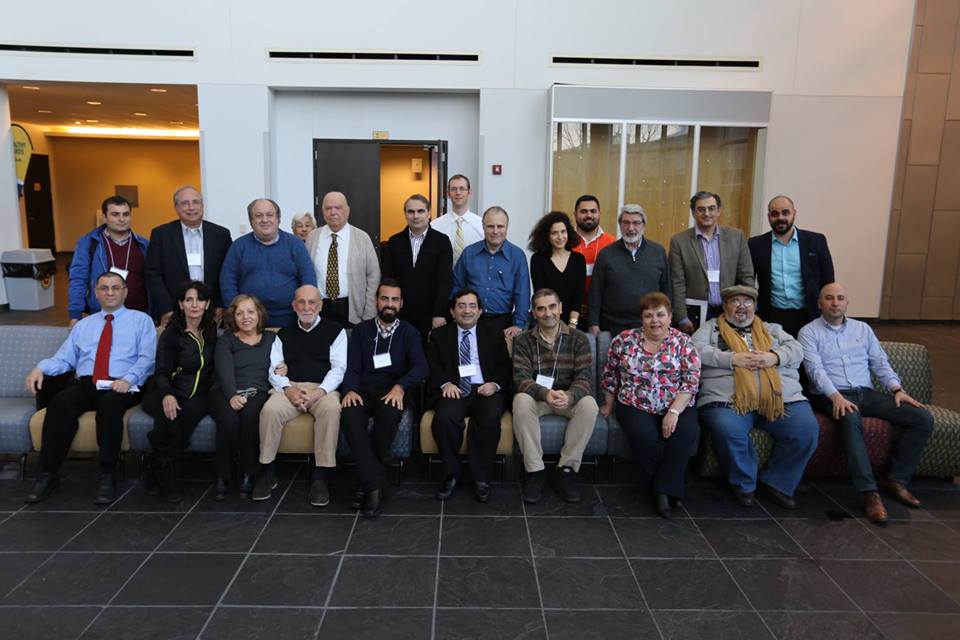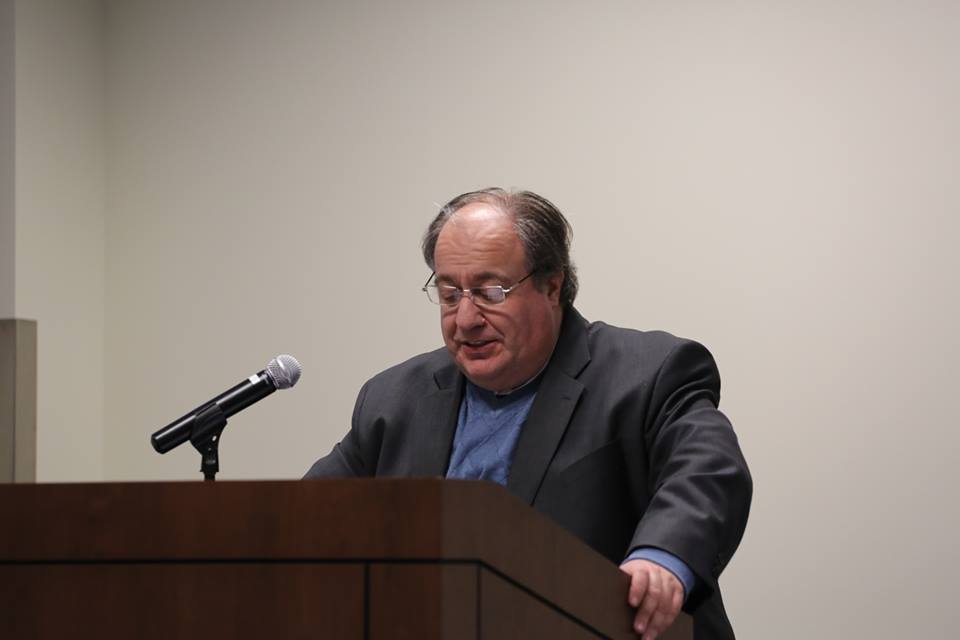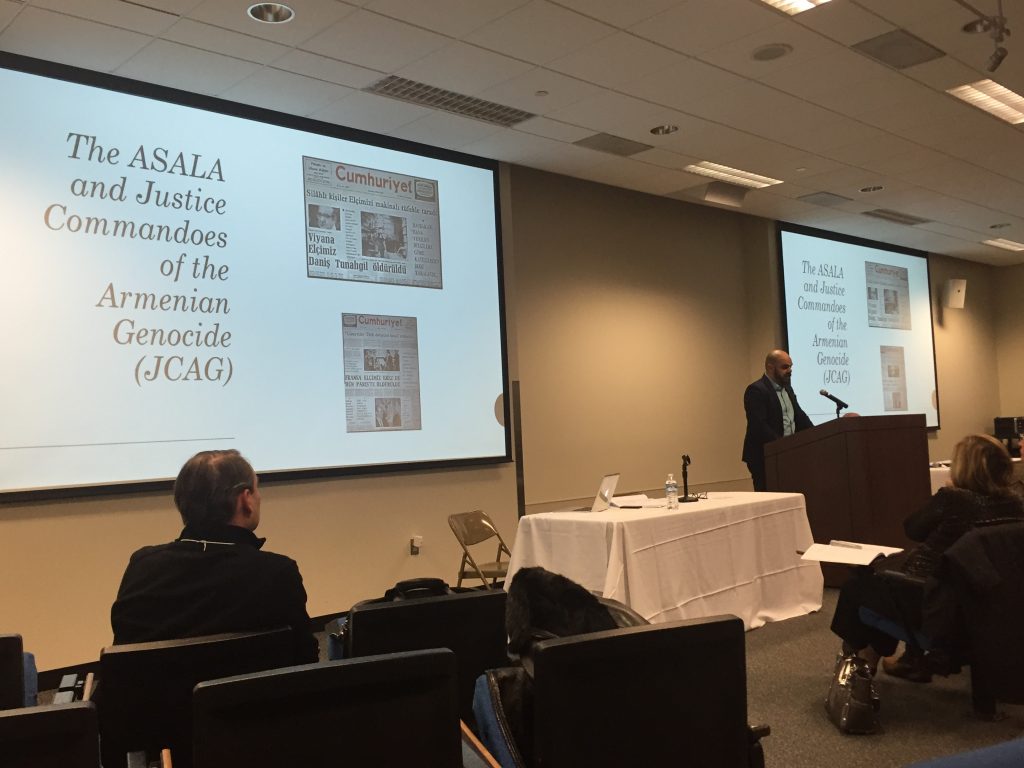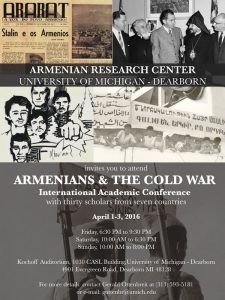DEARBORN, Mich.—The Armenian Research Center at the University of Michigan-Dearborn (UM-Dearborn) hosted an international academic conference on “Armenians and the Cold War” on the university’s campus from April 1-3. Nearly 30 scholars from across the world participated in the unprecedented conference, which spanned across several disciplines.
The conference kicked-off on the evening of April 1 with a meet and greet with the participants at the university’s College of Arts, Sciences, and Letters (CASL) Building. Dean of UM-Dearborn CASL Marty Hershock welcomed those in attendance. Asbed Kotchikian (Bentley University) editor of the Armenian Review and Gregory Aftandilian of the National Association for Armenian Studies and Research (NAASR) also shared words of welcome to participants and attendees. An introduction of the conference was given by Ara Sanjian, Director of the UM-Dearborn Armenian Research Center, who outlined the reasons why such a conference was organized and what purpose it serves.
The first panel, which took place on the evening of April 1, was entitled “An Armenian ‘Cold War’ before the Global Cold War?” and featured panelists Garabet K. Moumdjian, an independent historian, Pasadena, Calif.; Vahe Sahakyan of the University of Michigan, Ann Arbor; and Hazel Antaramian-Hofman of Fresno Community College. Cam Amin of UM-Dearborn served as panel chair, while Astrig Atamian of École des hautes études en sciences sociales, Paris served as discussant. Moumdjian’s paper focused on the Armenian Revolutionary Federation’s (ARF) collusion in the Kurdish rebellions of the 1920’s and 1930’s in Republican Turkey, in context of the search of the origins of Islamized Armenians in Turkey; Sahakyan’s paper looked at the changing course of the ARF during and after the Second World War; while Antaramian-Hofman’s presented on the post-WWII repatriation of American-Armenians to Soviet Armenia.
Saturday’s first panel was entitled “Armenian-Americans in the 1950’s” and featured panelists Levon Chorbajian of the University of Massachusetts, Lowell; Gregory Aftandilian of the American University, Washington, D.C.; and Benjamin F. Alexander of the New York City College of Technology (CUNY). Pam Pennock of UM-Dearborn chaired the panel and Khatchik DerGhougassian of the Universidad de San Andrés, Argentina, served as discussant (via Skype). Chorabjian’s paper focused on the opposing views of the Hairenik Weekly and the Armenian Mirror-Spectator at the time, with a particular focus on articled and editorials written in 1951; Aftandilian’s presentation focused on the writing of Hairenik and Armenian Review editor Reuben Darbinian during the Cold War; while Alexander’s talk centered around the ARF’s changing policies and views during the years of the Cold War.
Panelists Jirair Jolakian, editor of the Nor Haratch newspaper of Paris and Astrig Atamian of École des hautes études en sciences sociales, Paris, made up Saturday’s second panel entitled “The Armenian ‘Cold War’ in France. Jolakian’s presentation focused on the articles and editorials of Nor Haratch during the years of the Cold War, while Atamian’s paper looked at the “Garmir” communist movement among the Armenian community of France, during the Cold War. Professor Emeritus (UCLA) and Adjunct Professor of History (University of Southern California) Richard G. Hovannisian chaired the panel, while Asbed Kotchikian served as discussant.
Saturday’s third panel, entitled “The Armenian ‘Cold War’ in South America” was chaired by Kevork Bardakjian of the University of Michigan, Ann Arbor, and featured panelists Vartan Matiossian of the Armenian National Education Committee, New York; Heitor Loureiro of the São Paulo State University (UNESP); and Khatchik DerGhougassian. Simon Payaslian of Boston University served as panel discussant. Matiossian’s paper entitled “Fighting for History: An Unknown Polemics in the Beginnings of the Cold War” focused on the effect of Cold War politics on the South American Armenian communities; Loureiro’s paper focused on the rise of communism in the Armenian community of Brazil and its repression by the political police; while DerGhougassian focused on the pro-/anti- Soviet divide in the Armenian community of Argentina from the late 1940’s to the late 1980’s.
The conference’s fifth panel entitled “Armenians: Between a Soviet Homeland and the Diaspora,” featured panelists Nélida Boulgourdjian of the Universidad Nacional de Tres de Febrero, Argentina, and Gevorg Petrosyan of the Institute of Oriental Studies, National Academy of Sciences, Armenia. Boulgourdjian presented the background of Soviet policy toward Armenian communities of the diaspora, with a particular focus on the communities of France and Argentina between 1930 and 1950. Petrosyan’s paper focused on the impact of the Cold War and Turkish-Soviet relations on Armenians in Turkey and their relations with Soviet Armenia between 1945 and 1964. Anush Hovhannisyan of the Institute of Oriental Studies, National Academy of Sciences, Armenia chaired the panel, while Eldad Ben-Aharon of Royal Holloway (University of London) served as panel discussant.
After the panel, participants and attendees marked the 30th anniversary of the Armenian Research Center of UM-Dearborn with a reception honoring Gerald E. Ottenbreit Jr. and Alice Nigoghosian, for their years of dedicated service.
Sunday’s first panel entitled “The Armenian ‘Cold War’ in the Arab World from 1945 to 1970” featured panelists Hratch Tchilingirian of the University of Oxford, and James Stocker of the Trinity Washington University. Panelist Khatchig Mouradian of Rutgers University, who was to present his paper entitled “The Cold War of Genocide: April 24 Editorials in the Lebanese-Armenian Party Political Press, 1945-1970,” was not able to attend due to an illness. Levon Chorbajian served as panel chair, while Benjamin Alexander served as panel discussant. While both panelist’s presentations focused on the effects of the Cold War on the Armenian Apostolic Church, Tchilingirian’s paper explored the rift between Etchmiadzin and Antelias, while Stocker’s paper looked at the United States and the struggle within the church between 1956 and 1963.
After Sunday’s first panel, a roundtable discussion between participants and attendees took place, which compared the chronologies of the global Cold War and the Armenian “Cold War.” Ara Sanjian offered opening remarks and led the discussion.
The conference’s seventh panel explored the era of the Armenian Secret Army for the Liberation of Armenia (ASALA) and the Justice Commandos of the Armenian Genocide (JCAG) in the Middle East (1970’s and 1980’s). Eldad Ben Aharon, paper entitled “The Cold War and Mid-East Political Violence: An Israeli-American-Turkish Alliance?” explored the relations between the United States, Israel, and Turkey during the Cold War in the context of the Middle East and its Armenian communities. The second panelist, Emre Can Dağlıoğlu of Clark University presented on the changing identity of the Armenian population of Turkey during the Cold War. Nélida Boulgourdjian chaired the panel, while Vahe Sahakyan served as discussant.
The next two panels, entitled “Soviet Armenian Historiography and the Cold War” and “Arts and Popular Culture during the Armenian ‘Cold War’” took place together. Samvel Grigoryan an independent historian from Moscow presented on the impact of Soviet-Western relations on the historiography of the Armenian Kingdom of Cilicia; and Anush Hovhannisyan presented on the “private stories” of Armenian Genocide survivors in Soviet Armenia during the Cold War, in the first portion of the combined panel. Richard Hovannisian served as a discussant of the first two presentations, while Vartan Matiossian chaired. Tigran Matosyan of the American University of Armenia (AUA) then presented on the Armenian “Hippie” movement, which took place in Soviet Armenia in the 1960’s and 1970’s. Discussant Kevork Bardakjian, who served as discussant, shared his experiences from Soviet Armenia during those years. Neery Melkonian—an independent researcher, critic, and curator from New York City—was due to present on Armenian Diaspora Artists and the Cold War, but was unable to attend. Sally Howell of the University of Michigan, Ann Arbor, chaired the second portion of the panel.
At the conclusion of the conference, a second roundtable was held between participants and attendees. The discussion focused on the legacy of the Armenian “Cold War” and its impact today. The discussion focused on the three main aspects—the historical, political, and sociological—around which the Cold War affected Armenian communities around the world. Recommendations for future research and discussions were also made by those present.
Source: Armenian Weekly
Link: ‘Armenians and the Cold War’ International Conference Takes Place at UM-Dearborn




